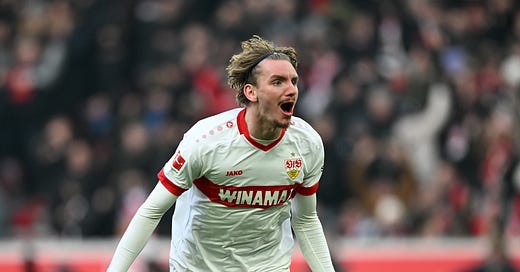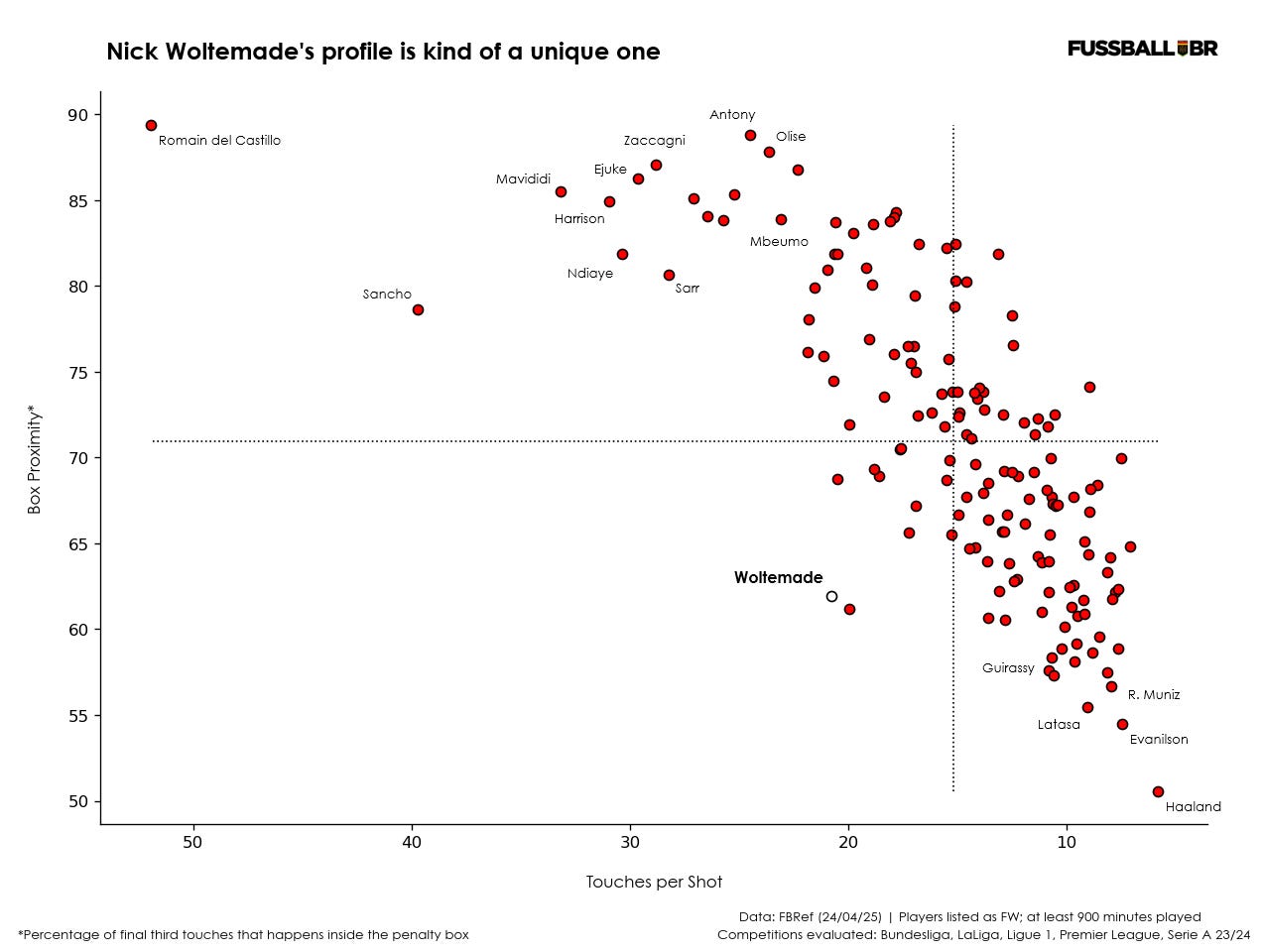VfB Stuttgart didn’t quite replicate their incredible Bundesliga campaign of 23/24 this season, but ended up winning the DFB Pokal, a well deserved reward for Sebastian Hoeness incredible work at the helm of this gigantic club.
At the centre of that, was Nick Woltemade. Signed on a free transfer from Werder Bremen, he started the 24/25 season as no more than a bench option but quickly established himself among the starting XI. A 1.98 meters tall striker, he scored 17 goals and made 3 assists for VfB Stuttgart and is getting recognition overseas for his unique profile.
History
A regular fixture in Germany's youth teams, Woltemade came up at Werder Bremen, where he made his professional debut in 2020. His opportunities at the northern German club were limited, however, and his professional breakthrough only came in the 2022/23 season, when he was loaned out to SV Elversberg, at that time playing in the German 3rd division. There, he was an undisputed starter, a key player in the club's title winning campaign and received the award for best player in the division.
The striker's performances motivated Bremen to keep the player in their squad for the following season and, although he showed flashes of potential, he scored only two goals in the Bundesliga in 30 games (twelve as a starter). Despite the low number of goals, his performances were enough to draw attention from VfB Stuttgart, who took advantage of Woltemade's contract situation to sign him on a free. Judging by his first year in Stuttgart, it seems to have been a great deal.
Roles and positions
VfB Stuttgart's predominant formation in the 24/25 season was a 4-2-2-2, playing two midfielders and two forwards up top. Alternatively, Sebastian Hoeness worked with three center-backs and a 4-2-3-1. Nick Woltemade played mainly as a forward in all of those scenarios.
Offensive Runs
Coming short
Woltemade is a forward who is constantly dropping back, receiving the ball with his back to goal to support the team's build-up play. This means that he breaks away from the defensive line to occupy positions closer to midfield, time after time. In fact, among other strikers in Europe’s Top 5 Leagues, he does accumulate an above average number of touches outside the penalty area, even if we only consider touches with the ball that occur in the final third. Notice how he’s kinda of an outlier in the graph below.
His teammates are constantly trying to find him to set up an attacking sequence, using wall passes to find another player. Most of his passes in these situations are short and simple, although he shows technical quality for more.
This is his favored run and Woltemade also makes a habit of playing back to goal when closer to the penalty box. See below how he sets up his body to receive the ball at his feet, using his arms to help absorb physical contact and protect it.
Despite this tendency and the fact that he is quite tall (something that may reinforce the stereotype that he is a strong and not very mobile striker), physical duels in that specific scenario is an aspect of the game that Woltemade still needs to improve. Although he demonstrates a good understanding of how to use his body and arms to gain marginal advantages, he is often physically beaten when facing a more aggressive defender, and can look clumsy when trying to control passes under heavy pressure or allow defenders to anticipate. Still, it is important to note that, compared to previous seasons, he has developed well in this back-to-goal game and has been on a upward trajectory.
On the other hand, the German is a surprisingly agile player and deals really well with situations in which the opponent gives him a little more space, turning under pressure and driving the ball forward via carries.
Runs in behind
Runs in behind are far less common in Woltemade's game and he is not a very aggressive player in that regard. There are situations in which he makes a move to push the defensive line closer to their own goal, but it is very rare to see him finish this run next to one of the goal posts, either to receive a pass and finish or to create space by dragging defenders. More often than not, he disconnects from the run upon realizing that the cross isn’t coming in his direction, braking and looking to get closer to the ball again.
Shooting
The striker's overall style is reflected in the main areas where he usually shoots. There are few shots closer to both posts and a large concentration in the central region of the area, near the penalty spot — expanding the analysis to the other seasons, the same situation would be observed.
Because he actively participates in VfB Stuttgart's build-up play and positions himself with his back to the opposing goal, it is common for Woltemade to arrive late in the box.
Furthermore, his tendency to not be as aggressive when running in behind creates situations in which he ends up positioning himself near the penalty spot, even after having started a run towards the baseline. Usually, takes shots with his favored right foot, showing good composure inside the box, and his first touch is fairly good to set up a shot.
Dribbles and carries
The aforementioned agility is a vital factor in one of the German main strengths: his ability to control the ball in tight spaces, dribble past defenders and eat ground through carries. One would not expect someone with his physical build to make sharp turns of direction as well as he does. Woltemade is not a particularly refined player technically and his height makes him look a little clumsy when dribbling, but the forward has an above-average success rate in this type of action and looks comfortable playing off both wings as well.
Among the top five leagues in Europe, the striker dribbling numbers brought him closer to the likes of Luis Diaz and Rafael Leão! The vast majority of players who are above (or near) the German are wingers who generally occupy the flanks, something that makes Woltemade's stats stand out even more.
Aerials Duels
His game in the air is another area where Woltemade needs to improve to become a more complete striker. He doesn't seem to be able to exploit his height (1.98m) to win aerial duels, largely due to a somewhat passive stance when faced with such opportunities — this is something that may be related to the lack of physical strength that also affects him when pressed hard from behind. In addition, his timing when attacking the ball leaves something to be desired and, as a result, it is more difficult to direct plays well.
Final thoughts
Suffering from a lack of reliable center-forwards options for quite some time now, Germany turned their attention to veterans Niclas Füllkrug and Tim Kleindienst and both have performed well when called upon - however, a younger option has been missing for the future of the German national team.
Woltemade combines characteristics that bring him closer to these center forwards, while maintaining the mobility and on-ball skills of other names already selected by Julian Nagelsmann. A call-up seemed to be just a matter of time and it came as soon as the club season ended: he made his debut in a 2-1 loss against Portugal.
There is still plenty of room for improvement, but Woltemade’s profile is one that has been increasingly sought on the market and should attract interest from lots of teams. His production exploded after he moved from Werder Bremen to VfB Stuttgart and it would not be surprising to see him maintain this average in the coming seasons.
That’s all for today. If you enjoyed this report, please drop a like, subscribe and share it so more people can see it. You might also like some of my other analysis, so be sure to check it out.
As always, appreciate any kind of support. Feel free to ask anything below and until next time!













Ah, enjoyed this. He's a player I recently found out about, and actually got him on a free too from Werder Bremen on football manager (before he moved to Stuttgart). He's beautiful to watch, and I'm surprised at his ball control and dribbling, especially for his size. Like Isak and Eketike, he's my type of striker: tall and learn, silky, and free flowing. They're beautiful to watch.
Enjoyed reading this. On his aerial duels and header, was he always this tall, or did he hit a growth spurt? I read once that Haaland wasn't always that big as a boy and so developed good penalty box movement to gain and advantage, and when he exploded in size, he combined his newfound size and strength with the movement one would see in smaller strikers.
Don't know if this happened with Isak or Eketike, but it'd seem not being so good at aerial duels may be because it didn't offer him an advantage in youth football.
Nice visuals, they're simple and clean. Do you collect the data all at once from Fbref or one league's data at a time?